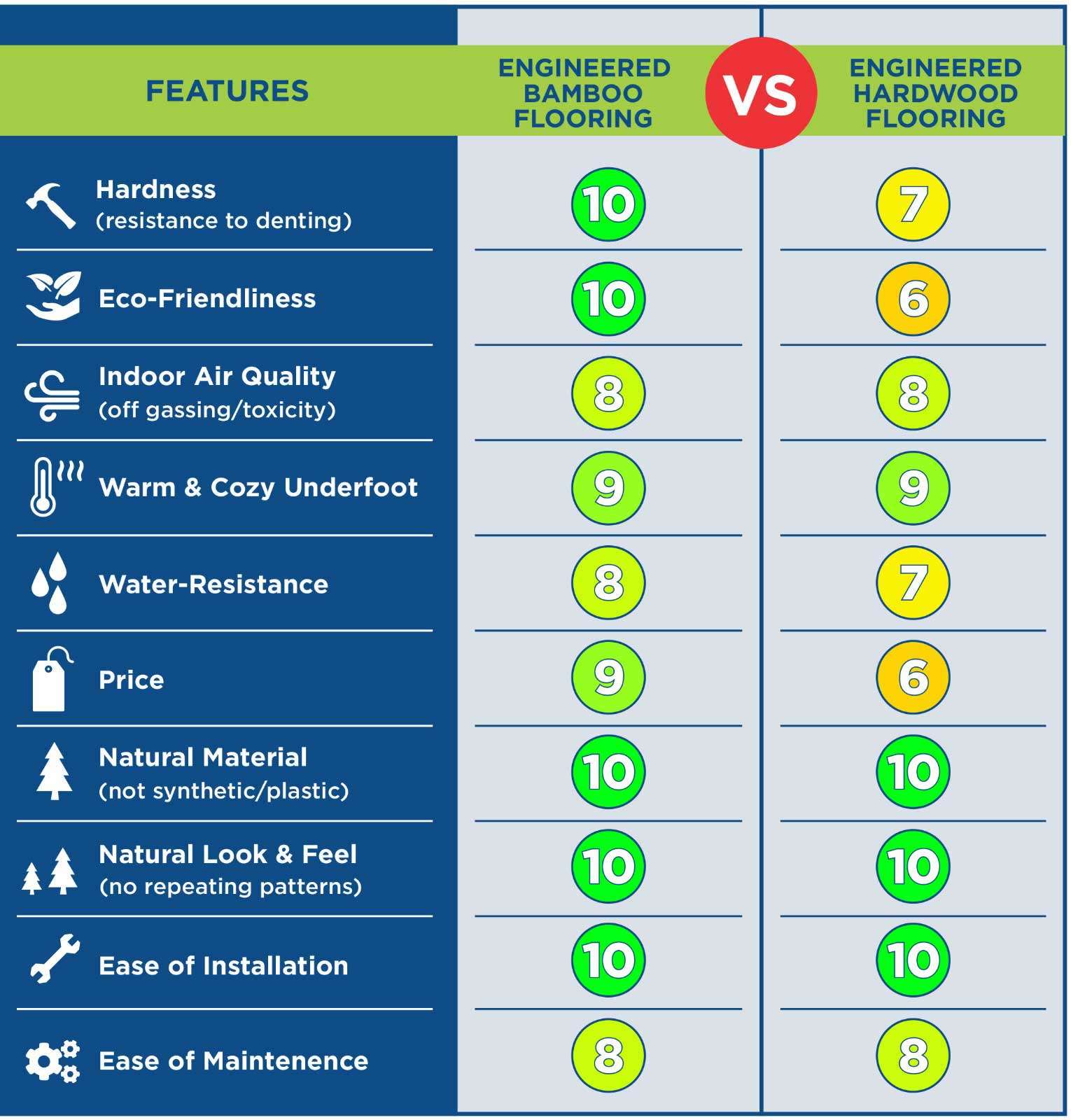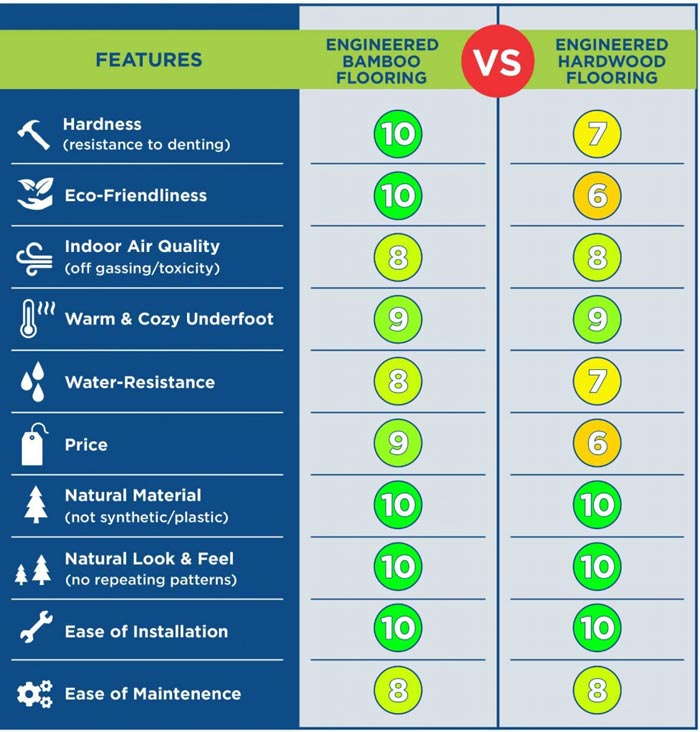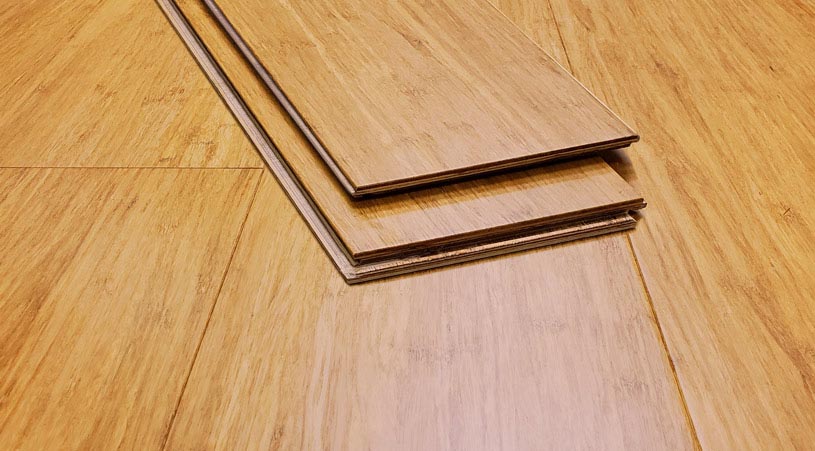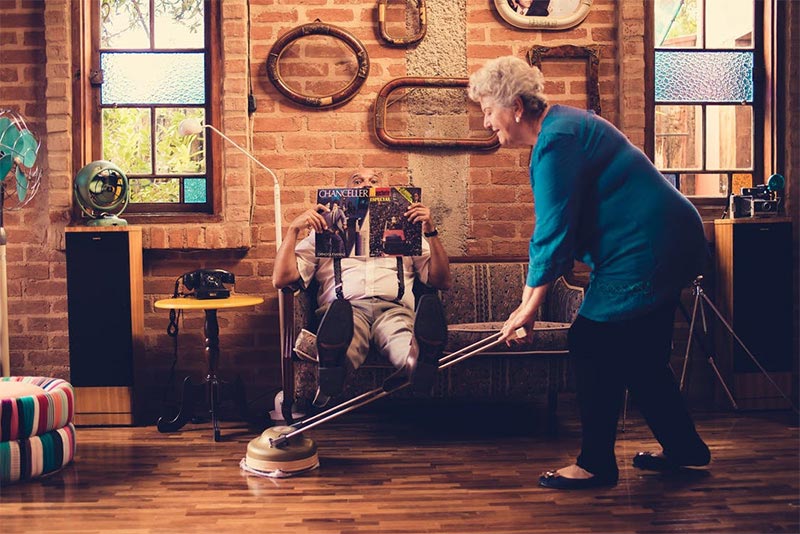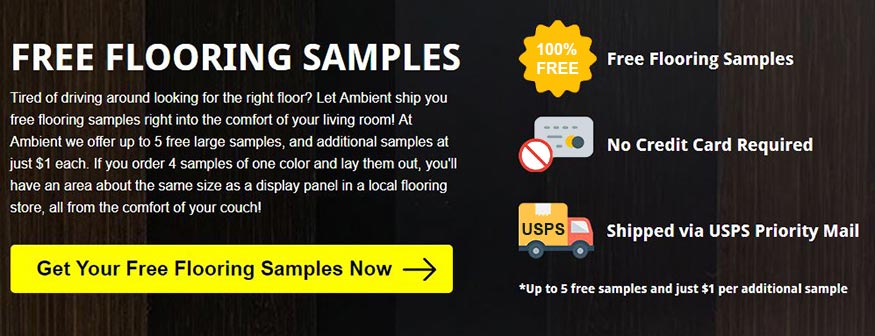Engineered bamboo flooring and engineered wood flooring are composite products made up of several layers, of which the upper layer or “wear layer” is either bamboo or real hardwood. The other layers may be plywood, hardwood, or high-density fiberboard. These layers are glued together, often in a cross-grain configuration, to minimize sensitivity to changes in humidity. But which of these has the edge? Here, we provide you with a detailed comparison of the two flooring options and score the most important features out of ten. So, add up the scores, concentrating on what is most important to your home improvement project. It’s the best way to make a decision.
KEY DIFFERENCES BETWEEN ENGINEERED BAMBOO FLOORING AND ENGINEERED HARDWOOD FLOORING – A GUIDE
HARDNESS (Resistance to Denting)
Engineered Bamboo Flooring
Engineered bamboo flooring options, especially the strand woven variety, is made from the hardest natural flooring material you will find – strand woven bamboo. It is considerably harder than the hardest of hardwoods, so it is highly resistant to denting. That doesn’t mean it’s totally indestructible, but it’s dang near close, as far as flooring goes. We’ve even seen bamboo flooring used as a flooring surface in home garages – so people park their cars on it! We measure the hardness of wood species by using the Janka scale, which measures the relative hardness of wood by measuring the amount of force required to embed a .444-inch steel ball to half its diameter into a material.
It is worth reading if you want to understand how some woods are much harder than others. For hardness and resistance to denting, engineered bamboo scores 10 out of 10.
Engineered Wood Flooring
As we have already said in the previous paragraph, bamboo is much harder than hardwood, so you might expect it to be much harder than engineered hardwood. You would be right in this assumption. The top hardwood layer determines the hardness of engineered wood flooring, so it is the same as hardwood and much less resistant to denting than bamboo, on average. It gets just 7 out of 10 for hardness. Speaking of heavy things on wood floors, here is a useful tip on moving an upright piano that doesn’t involve heavy lifting.
INDOOR AIR QUALITY, OFF-GASSING, & FORMALDEHYDE EMISSIONS
Most of us take for granted that the air we breathe in our homes is reasonably pure. However, that is a big mistake. It’s up to ten times more polluted than the air outside. The main culprits are (VOCs) emitted from all the stuff in our homes, including building materials, carpets, paints, and so forth. These pollutants potentially damage your health, so we advise you to keep them to the minimum. Proper ventilation helps make good decisions on the materials you use for your home improvement projects.
Engineered Bamboo Flooring
Engineered bamboo flooring produces only a small quantity of VOCs, which comes from the adhesive used in its manufacturing process to glue the various layers together. However, you don’t need to worry about this because the levels are well below government recommended VOC limits. You can safely install engineered bamboo floors without any risk to your health from VOCs. We give it an indoor air quality rating of 8 out of 10.
Engineered Wood Flooring
You don’t need to worry about engineered wood flooring, either. Its structure is similar to engineered bamboo flooring, and it emits similarly low quantities of VOCs. So, it also scores 8 out of 10. We doubt if you’re old enough to remember The Hollies’ take on the air that you breathe – but it is a classic!
COMFORT FOR WALKING / WARM UNDERFOOT
Engineered Bamboo Flooring
Kick-off your shoes and stretch your toes. What can feel better than walking barefoot on an engineered bamboo floor? We weren’t made to wear shoes. Bamboo floors feel comfortable and warm because bamboo, a grass, has a very low thermal conductivity, so it doesn’t drain the heat away from your feet. Walking barefoot is good for your health, too; here are several benefits it offers. Don’t worry; you won’t get any splinters. Additionally, since most engineered bamboo is installed over a 3-in-1 underlayment, you’ll get the added benefit of some cushioning for your back. For the comfort of walking, engineered bamboo achieves 9 out of 10.
Engineered wood flooring
Can you tell the difference between engineered bamboo floor and engineered wood floor just by walking barefoot on them? If you can, then you must have susceptible feet. We don’t think there’s much of a difference, so engineered wood flooring also scores 9 out of 10 for the comfort of walking.
WATER RESISTANCE
Engineered Bamboo Flooring
One of the crucial benefits of engineered bamboo flooring compared with hardwood is that it is more water-resistant. Therefore, you can install it in kitchens and other places where it is likely to get wet occasionally. As long as you wipe up any spills reasonably quickly (within 24 hours), you are good to go. Although water droplets will dry up, you’ll want to avoid leaving puddles on bamboo for more than 24 hours, or you’ll risk the bamboo staining and swelling. One reason bamboo is more resistant to water than hardwood is its structure. Because it is grass, it doesn’t have the same kind of porous grain structure as hardwood, so it doesn’t soak up water quickly. For water resistance, we give it 8 out of 10.
Engineered Wood Flooring
Engineered wood flooring is less waterproof than bamboo for the reasons we give in the previous paragraph. It can tolerate a small amount of water, but you should wipe spills up as soon as you can. You don’t have 24 hours of grace as you do with bamboo. It’s not the best solution for areas such as your kitchen, where you would always worry about damaging it. For water resistance, it scores 7 out of 10.
PRICING & AVAILABILITY
Engineered Bamboo Flooring
When comparing apples to apples in terms of thickness of the wear layer, engineered bamboo flooring is much cheaper than any comparable (same plank dimensions) wood floor. This is because it is highly sustainable, grows exceptionally quickly, and reaches maturity in just five years. It can also regenerate after harvesting, so it doesn’t need replanting, which prevents soil erosion. It is readily available, so don’t worry about encountering any shortages. Additionally, engineered strand bamboo flooring rarely, if ever, needs to be refinished in a residential setting. It isn’t scratched by pet claws – instead of engineered hardwoods, which look all dented up after a few short years – so the life-cycle and long-term value of bamboo are much higher. It scores 9 out of 10 for pricing.
Engineered Wood Flooring
Engineered wood flooring costs considerably more than bamboo; its costs are similar to those of solid hardwood. This is because trees take a long time to grow, with most flooring species taking 40 years or more to grow to maturity. Like bamboo, it is readily available. For pricing, we give engineered wood flooring 6 out of 10.
ORGANIC, NATURAL MATERIALS VS SYNTHETIC
Engineered Bamboo Flooring
Engineered bamboo flooring is entirely natural. We agree that a little glue and resin are used in its manufacturing process, but in minuscule quantities. Other than that, it is 100% natural. Since you can’t get more natural than nature, engineered bamboo flooring scores 10 out of 10.
Engineered Wood Flooring
Engineered wood flooring has the same natural credentials; after all, it is made mainly of wood, though a small quantity of glue and resin is used to manufacture it. Engineered hardwood flooring also scores 10 out of 10.
NATURAL VARIATION IN THE GRAIN – LOOK AND FEEL
Engineered Bamboo Flooring
Strand weaved engineered bamboo flooring looks and feels very similar to hardwood flooring, which is why many people choose it. Its grain pattern has a truly unique marbling effect that looks gorgeous. If anything, bamboo is even more exotic; see for yourself in the picture below. It’s a picture of strand woven engineered bamboo flooring that demonstrates its beautiful color tone and grain. Every plank is unique, and you will never find a repeated pattern. For natural variation in the grain, it deserves full marks: 10 out of 10.
Engineered Wood Flooring
Because the surface of engineered wood is a natural hardwood, it will always exhibit a natural variation. The amount depends on the grain size, growth rings, and knots, and just as with bamboo, every board will have its special character. There is no doubt, a good quality engineered wood floor will always look great; we give it 10 out of 10.
EASE OF INSTALLATION
Both engineered bamboo and engineered hardwood are easy to install, thanks to the click-lock systems they both use. No gluing or nailing is needed, so it’s much easier to plan to do the installation yourself. The necessary steps for installing these flooring options are:
- Acclimate the wood – let it sit (with boxes cut open to breathe) in your home for around 3-10 days before installing it. This will allow it to adapt to the humidity level and temperature of your home.
- Prepare the subfloor – you can lay the flooring on the cleanest, dry, level, and firm subfloors. However, if you are installing it on a new concrete floor, you must wait until the concrete has thoroughly dried or used a quality 3-in-1 underlayment.
- Underlayment is highly recommended. It will even out small bumps, protect the floor from moisture, muffle footsteps noise, and reduce sound transmission between levels in your home.
- Leave an expansion gap between the boards and the walls when you lay the planks.
- Finally, install perimeter trim/moldings such as quarter round or baseboard to hide the expansion gaps.
For ease of installation, both engineered bamboo and engineered hardwood flooring score 10 out of 10. Here is a detailed guide on installing engineered bamboo flooring.
EASE OF MAINTENANCE
Maintenance on bamboo or hardwood floor is easy. Ideally, you’ll vacuum your floor a few times each week or sweep it using a soft brush broom. Avoid harsh detergents and acidic or alkaline products, and never use wax polish or abrasive materials. You can mop the floor using a lightly damp microfiber mop, but avoid excess water and dry the floor after mopping. That’s all you need to keep your floor looking great for many years to come. For ease of maintenance, both engineered bamboo and engineered hardwood flooring score 8 out of 10. Alternatively, sit back and let somebody else do the work!
THE FINAL ANALYSIS
Have you been keeping a check on the score? Both engineered bamboo and engineered wood flooring are excellent options, but engineered bamboo flooring has the edge in the final analysis. The final scores are: Engineered bamboo: 93 points Engineered hardwood: 81 points

